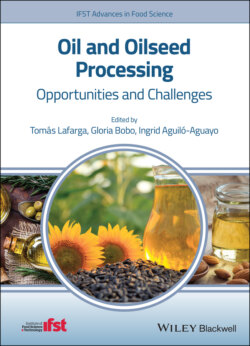Читать книгу Oil and Oilseed Processing - Ingrid Aguilo-Aguayo - Страница 2
Table of Contents
Оглавление1 Cover
2 Series Page
3 Title Page
4 Copyright Page
5 Preface
6 List of Contributors
7 1 Production and Consumption of Oils and Oilseeds 1.1 Introduction 1.2 Oilseeds and Oils: Production and Trade 1.3 Novel Sources for Oil Production 1.4 Summary Acknowledgments References
8 2 Conventional Oils and Oilseeds: Composition and Nutritional Importance 2.1 Introduction 2.2 Oilseeds 2.3 Factors Affecting Oil Yield 2.4 Overview of Oilseed Processing and Current Applications Acknowledgments References
9 3 Novel Sources for Oil Production 3.1 Introduction 3.2 Algae 3.3 Insects 3.4 Unconventional Plants and Seeds 3.5 Opportunities, Challenges, and Future Prospects Acknowledgements References
10 4 Oils Extracted from Nuts and Grains 4.1 Introduction 4.2 Oils 4.3 Nut Lipids 4.4 Grain Lipids 4.5 Conclusions References
11 5 New Approaches to Detect Compositional Shifts in Fish Oils 5.1 Introduction 5.2 Production and Processing 5.3 Nutritional Benefits 5.4 Oxidative Stability 5.5 Methods for Quality Assessment 5.6 Conventional Methods 5.7 Machine Learning Approaches toward the Detection of Compositional Shifts 5.8 Future Perspectives References
12 6 Milk Fats 6.1 Introduction 6.2 Health Effects of Milk Fats 6.3 Pre‐Treatment and Processing Technologies 6.4 Techniques for Obtaining Functionality of Milk Fats 6.5 Current and Potential Applications in the Food Industry and Other Areas 6.6 Non‐food Uses of Milk Fats 6.7 Future Trends References
13 7 Oils and Their Use Beyond the Food Industry 7.1 Introduction 7.2 Seed Oils for Non‐food and Industrial Applications 7.3 Industrial Applications of Seed Oils 7.4 Conclusions and Future Prospects References
14 8 Occurrence and Determination of Contaminants in Edible Oils and Oilseeds 8.1 Introduction 8.2 Mycotoxins 8.3 Polycyclic Aromatic Hydrocarbons 8.4 3‐MCPD Esters and Glycidyl Esters 8.5 Mineral Oil 8.6 Phthalates 8.7 Pesticides 8.8 Conclusions Acknowledgments References
15 9 By‐Products from Oilseed Processing and Their Potential Applications 9.1 Introduction 9.2 Oilseed by‐Products: Origin, Characteristics, and Composition 9.3 Nutritional Composition and Functional Properties of Oilseed by‐Products 9.4 Antinutritional Compounds 9.5 Current Applications in the Valorization of Oilseed by‐Products 9.6 Future Trends References
16 10 Proteins and Peptides Derived from Rapeseed: Techno-Functional and Bioactive Properties 10.1 Introduction 10.2 Summary of Existing Rapeseed Meal Protein Extraction Processes 10.3 Hydrolysis of Rapeseed Proteins and Rapeseed Meal to Produce High Value Bioactive Compounds 10.4 Techno‐Functional Attributes of Rapeseed Proteins 10.5 Bioactivities of Rapeseed Protein Hydrolysates and Identified Bioactive Peptides 10.6 Safety of Rapeseed Proteins and Hydrolysates 10.7 Conclusion References
17 11 Oils and Oilseeds in the Nutraceutical and Functional Food Industries 11.1 Introduction 11.2 Functional Food and Nutraceuticals 11.3 Vegetable and Seed Oils as Source of Bioactive Compounds 11.4 Bioactivity of Vegetable Oils and Oilseeds 11.5 New Trends and Applications References
18 12 Sensorial Evaluation and Aroma of Vegetable Oils 12.1 Introduction 12.2 Olive Oil 12.3 Palm Oil 12.4 Soybean Oil 12.5 Sun Flower Seed Oil 12.6 Corn Oil 12.7 Peanut Oil 12.8 Coconut Oil 12.9 Linseed/Flaxseed Oil 12.10 Canola or Rapeseed 12.11 Hazelnut Oil 12.12 Avocado Oil 12.13 Almond Oil 12.14 Pistachio Oil 12.15 Sesame Oil 12.16 Walnut Oil References
19 Index
20 End User License Agreement
